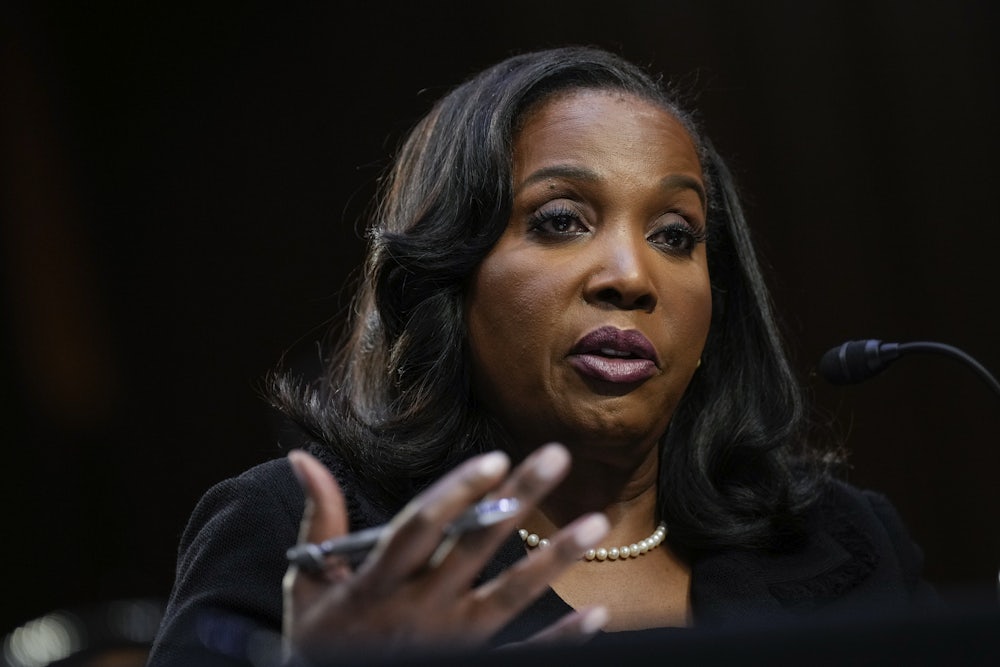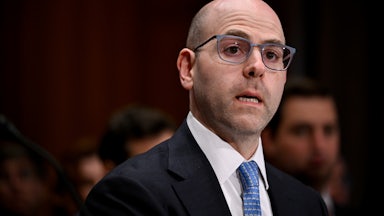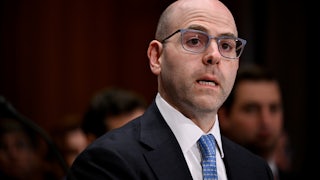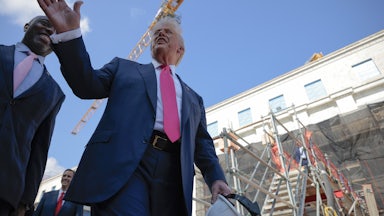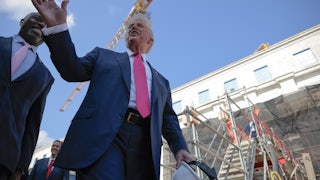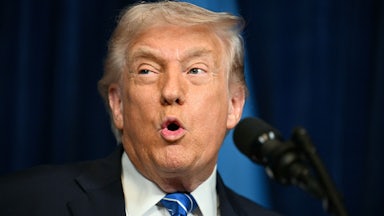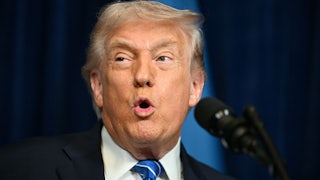Rarely is it obvious that a lawsuit will turn into a landmark Supreme Court decision at the outset. Cook v. Trump is the exception. At stake is nothing less than the future health of the American economy and the basic structure of the federal government.
Federal Reserve Governor Lisa Cook filed a lawsuit against President Donald Trump on Thursday to block his attempt to illegally remove her from her position atop the nation’s central banking system. In a letter earlier this week, Trump told Cook that she was “hereby removed from your position on the Board of Governors of the Federal Reserve, effective immediately.”
Trump, like other presidents, can lawfully fire many top government officials in the executive branch at will. For roughly a century, Congress and the courts have held that there are limits to that power. Members of the Federal Reserve Board of Governors—“the Fed,” as it is more commonly known—like Cook can only be fired “for cause” under longstanding federal law.
In his letter, Trump cited allegations of mortgage fraud by Cook prior to her confirmation in 2022 to justify her removal. Those claims came to his attention via a Trump loyalist atop the Federal Housing Finance Agency, who has made similar allegations against other prominent political opponents of the president to justify prosecuting them.
Cook described those allegations as a mere pretext in her lawsuit. She cited ample public evidence and statement to argue that Trump is trying to impose his will upon the Fed. The president has long criticized Jerome Powell, the Fed’s widely respected chairman, and other board members for not being aggressive enough about lowering interest rates. He favors a more expansionary policy that could undermine the Fed’s statutory mandate to keep inflation in check.
Powell, Cook, and the other five Federal Reserve governors automatically serve on the Federal Open Market Committee, a separate body that also includes some of the presidents of the regional Federal Reserve banks. The FOMC has various levers to influence the growth and contraction of the U.S. money supply, which has wide-ranging implications for inflation, debt, and capital markets. (For clarity’s sake, and for this lawsuit’s purposes, it is enough to refer to this entire operation as simply, “the Fed.”)
“Presidents, facing pressure to boost the economy, may favor lower interest rates and a more expansive policy to achieve a temporary economic lift,” Cook warned. “However, this approach often fuels long-term inflation. A politically insulated Board of Governors can make appropriate, albeit unpopular, decisions—such as raising interest rates to combat inflation—that are crucial for the nation’s long-term financial health.”
She also warned that future presidents could take even more destructive paths if given direct control over the Fed’s monetary levers. “An independent Federal Reserve also prevents presidential administrations from using monetary policy for self-serving political ends in other ways, such as ensuring the government cannot simply print more money to finance debt,” she noted. “This practice, when unchecked, can lead to economic collapse and hyperinflation.”
In her filing, Cook takes pains to note that the Federal Reserve Act of 1913, or FRA, foresaw these potential problems, and built in a wide range of safeguards to prevent such abuses. Foremost among them are that the president cannot simply replace members of the board at a whim. They are appointed to 14-year terms that are staggered two years apart from one another, and they cannot be dismissed early from their positions except in extreme circumstances.
“The ‘for cause’ removal protection guaranteed by the FRA, which has been the bulwark of the Federal Reserve’s independence for the past century, prevents the President from firing a Federal Reserve Board governor except ‘for cause,’ meaning instances of inefficiency, neglect of duty, malfeasance in office, or comparable misconduct,” she argued. As a result, no president had attempted to fire a Federal Reserve governor before this week.
The law, such as it is, is on Cook’s side. In addition to the statutory protections of the FRA, the Supreme Court has long upheld removal protections for members of certain independent agencies led by multi-member boards or commissions. In 1935, the justices held in Humphrey’s Executor v. United States that similar protections for the commissioners of the Federal Trade Commission were lawful because of the “quasi-legislative” and “quasi-judicial nature” of the agency.
Humphrey’s Executor is a longtime target of the conservative legal establishment, which favors a “unitary” executive branch that wields absolute control over any and all federal agencies. To that end, the Roberts Court has overturned for-cause protections for the singular leaders of the Consumer Financial Protection Bureau and the Federal Housing Finance Agency in recent years. In May, it also declined to block Trump from dismissing members of the National Labor Relations Board and the Merit Systems Protection Board in Trump v. Wilcox, even though they are structured as multi-member commissions.
Many legal observers assumed that the court would not completely overturn Humphrey’s Executor because it would imperil the Fed’s independence, which in turn could have dire consequences for American financial markets and the nation’s long-term monetary health. The court’s refusal to intervene in Wilcox rendered Humphrey’s Executor practically moribund for formerly independent agencies. But the conservative majority also used the opportunity to implicitly warn Trump against moving against the Fed.
The plaintiffs in Wilcox gave the justices the opportunity to do so by arguing that rejecting their motion would implicate the Fed as well. “We disagree,” the justices replied in their unsigned opinion. “The Federal Reserve is a uniquely structured, quasi-private entity that follows in the distinct historical tradition of the First and Second Banks of the United States.”
This bespoke “Fed-only” exception reflects more than a century of debate before 1913 over whether the U.S. should have a central banking system at all. The First and Second Banks of the United States had 20-year charters that ended when Congress (in the first case) and Andrew Jackson (in the second case) declined to renew them. Jackson, who successfully slew the bank and kickstarted the Panic of 1837, is a longtime political hero of Trump.
The American economy then cycled from one banking panic to the next until 1907, when a major one nearly collapsed Wall Street. In response, Congress spent years considering solutions until it settled upon the creation of the Federal Reserve as we largely know it today. It is no surprise that Cook leaned heavily on the court’s fleeting shadow-docket reference to the Fed to buttress her own lawsuit.
One challenge for Cook and the court is that, because prior presidents had almost never challenged the for-cause protections for various federal agencies, there is not much precedent on what counts as a justifiable “cause.” The FRA, unlike some comparable statutes, did not define the term further. Generally speaking, she noted, the protection applies except in cases of “inefficiency, neglect of duty, or malfeasance in office,” borrowing the phrasing from Humphrey’s Executor.
That last bit of phrasing—“malfeasance in office”—is particularly helpful for Cook. Even if the mortgage fraud allegations against her are true, they took place before her confirmation vote in 2022. (Cook is vague and elliptical about the veracity of the mortgage-fraud allegations, likely because the FHFA director referred them to the Justice Department for potential criminal investigation.) There is some common sense to this approach as well: It is arguably the Senate’s duty to keep out improper nominees before confirmation, and the president’s duty to ensure their good conduct thereafter.
Cook also argued that the president violated her Fifth Amendment rights by removing her without due process. “Governor Cook received neither notice nor a hearing before her purported firing,” she noted in her complaint. “Instead, she found out about the attempt to remove her through President Trump’s Truth Social post containing a letter addressed to her stating that ‘You are hereby removed from your position on the Board of Governors of the Federal Reserve, effective immediately.’” Again, common sense is on her side: If a for-cause appointee can’t meaningfully challenge the lawfulness of their removal, then it isn’t really a for-cause protection at all.
As I noted earlier this week, it is still possible that the Supreme Court botches this case. The court’s conservative majority has given Trump practically whatever he wants over the past two years. Supreme Court precedent and black-letter federal law have not significantly impeded him as he broadly restructures the federal government—and, to some degree, the nation—in his own image. At the same time, the justices drew a clear line in the sand here. Cook’s lawsuit makes it as easy as possible for them to hold it. The economic consequences of bowing to Trump once again, as Cook makes clear, are too immense to ignore.
